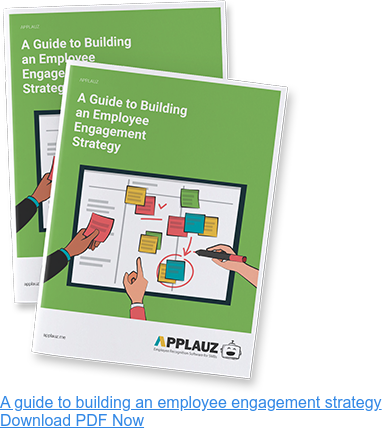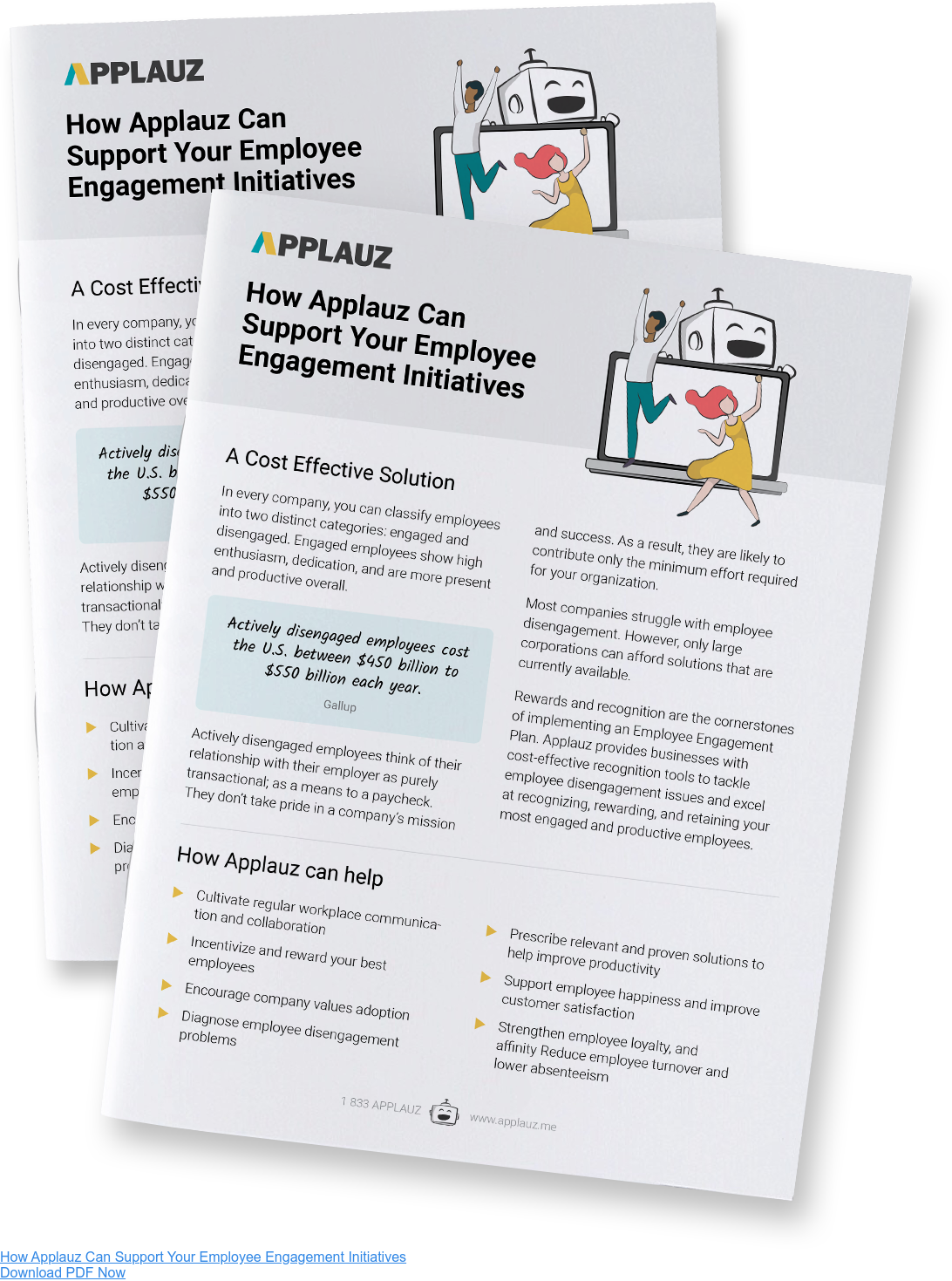Most organizations care about engaging employees. Most organizations also face challenges and demands that can clash with their intentions to keep employees engaged.
It’s why reaching optimal employee engagement levels isn’t a one-time effort. There is no ultimate finish line. Engagement is a continuous dance that involves being aware of the employee experience as your business evolves and adapting HR and culture-building efforts accordingly.
To improve employee engagement, you need to understand the relationship that engaged employees have with their work and organization.
It turns out, there are four types of employee engagement – and each one of them is important in its own way. Here is everything you need to know about them (and how to leverage them to boost productivity).
 What is Employee Engagement?
What is Employee Engagement?
While definitions of employee engagement vary, they all gravitate around the same theme: connection. Employee engagement is a state – and that state is also expressed through actions.
This state is an indicator of the level of connection, commitment and enthusiasm that employees feel towards their work and organization. This is reflected in their relationship to work and the way they show up and contribute.
When some leaders and HR professionals talk about employee engagement, they gauge it from the outside or try to get candid feedback about the way employees feel through tools like employee surveys.
Do employees feel valued? How committed and dedicated to core business and goals are they? How satisfied are they with their jobs and workplace environment?
Do they feel valued and appreciated for their contributions? Do they perceive their workload to be fair and responsibilities to be clear? Is there trust and psychological safety within the company culture?
All of these questions measure key factors that impact employee engagement.
 The 3 Employee Engagement Levels
The 3 Employee Engagement Levels
It would be easier to look at employee engagement as something that is either present or absent. In reality, it exists on a spectrum, with different levels of engagement between employees and within an employee’s journey in an organization.
This spectrum can be broken down into three employee engagement levels, which can help you assess your team’s current reality.
Actively Engaged Employees
Actively engaged employees represent the ideal scenario. They are passionate about their role and fully committed to the company's mission and goals. They enjoy showing up to work and uplift others in the process.
They take initiative and are proactive about solving challenges and seeking opportunities. They are excellent collaborators and have a positive outlook on the company's future.
According to Gallup, 33% of U.S. employees fall into this category.
Actively Disengaged Employees
Actively disengaged employees exist on the other side of the spectrum. They have a negative outlook about their role and organization and may feel resentful. They often underperform on purpose and have zero job satisfaction.
They don’t invest in team-building activities or development opportunities and don’t go out of their way to be helpful. They may even sabotage organizational efforts. And they are likely to be looking for other jobs and preparing for their exit.
According to Gallup, 16% of U.S. employees fall into this category.
Disengaged Employees
Disengaged employees are somewhere in the middle of the two categories above. They are simply not engaged, but they aren’t actively looking to act on their dissatisfaction. They don’t feel connected to their jobs or organization. As a result, they do the bare minimum.
They may “quiet quit” yet not have the motivation to seek new opportunities elsewhere. They punch the clock without much energy or passion.
According to Gallup, 50% of U.S. employees fall into this category.
Keep in mind that it’s easier to prevent disengagement and increase engagement than to turn around employees who have reached a state of active disengagement. Where would your team members fall on this spectrum?
 Types of Engagement and Why They Matter
Types of Engagement and Why They Matter
Learning about the spectrum of engaged employees can be eye-opening. With over half of the workforce in a disengaged state, we (unfortunately) have our work cut out for us.
Investing in employee engagement strategies is worth it though. Gallup research shows a relationship between employee engagement and 11 business outcomes tied to employee performance:
- Customer loyalty/engagement
- Profitability
- Productivity
- Turnover
- Safety incidents
- Shrinkage (theft)
- Absenteeism
- Patient safety incidents
- Quality (e.g. product defects)
- Wellbeing (thriving employees)
- Organizational citizenship (participation)
When choosing engagement initiatives, consider that there are four types of employee engagement – and they all matter in terms of keeping employees connected and committed.
Cognitive Engagement
In academic settings, behavioral engagement refers to students' participation and involvement in learning. In the workplace, cognitive engagement plays a similar role. There are a couple of facets to it.
The first one is about understanding and buying into where a company fits within the marketplace, what its goals are and what is required to achieve those goals. It also involves having a clear understanding of your individual role and responsibilities and how it fits into that picture.
Cognitive engagement also pertains to an employee’s mental investment in their work. Do they fully focus on tasks, analyze problems and work towards solutions? Do they brainstorm ideas to meet individual, team and organizational goals?
This type of critical thinking and problem-solving is cognitive engagement at play. It fuels high-quality work, innovation and organizational alignment. Employees who are cognitively engaged raise the bar and encourage others to perform at higher levels too.
Tips to increase cognitive engagement:
- Clearly communicate organizational objectives on a regular basis.
- Make sure team members have clarity around expectations and job responsibilities.
- Invest in the career development of your employees by offering access to learning and advancement opportunities.
- Foster innovation by encouraging employees to take risks and try new things.
Emotional Engagement
When employees are emotionally engaged, they are passionate about what they do and proud of their company's mission. They feel a strong sense of purpose at work and have an emotional connection to their jobs.
Imagine starting the day feeling excited about leading a project forward. You’ve made it your mission to see it through and to deliver exceptional work. The process is fulfilling – it’s allowing you to learn and grow in new ways and you are enjoying the challenge.
Plus, you feel lucky to work for a company that shares some of your core values. It feels great to know that the project will positively contribute to clients’ lives.
This is a perfect example of the experience of emotionally engaged employees. Emotional engagement is such an important pillar of engagement because it fuels motivation and enhances job satisfaction. Emotionally engaged workers are more likely to go above and beyond to help others out or take on additional responsibilities.
Tips to increase emotional engagement:
- Get clear on your organization's values, communicate them frequently and walk the talk, so to speak.
- You can also reward employees based on your values to reinforce them.
- Create a supportive environment where employees get to do work they enjoy and care about.
- Tie individual and team goals to a bigger positive impact – meaningful work isn't just about the bottom line.
- Create a comprehensive employee recognition program to help team members feel valued (a platform like Applauz can help).
Physical Engagement
Physical engagement is about physical presence (are your employees at work?), but it’s also about the quality of said physical presence (are they healthy and energized while at work?).
This type of engagement may be more evident in hands-on roles and industries like manufacturing or healthcare, but it’s crucial regardless of the setting.
Not only does it directly impact productivity and work quality, but it’s also essential for a healthy workplace culture.
Workplaces with a higher percentage of absenteeism and turnover likely have issues with physical engagement (and possibly other types of employee engagement, too). In other words, it’s a bad sign if physical engagement suffers – and its mere presence should be a baseline, not a win.
Tips to increase physical engagement:
- Make sure that team members have a safe and comfortable working environment.
- Promote a healthy work-life balance to prevent burnout.
- Offer wellness initiatives and health benefits.
- Be mindful of workload and give employees the tools to perform their roles without feeling stretched thin.
Social Engagement
Social engagement is about the way team members interact with each other and build relationships within the workplace. Socially engaged employees tend to be more collaborative, enjoy teamwork and have a positive attitude.
From participating in team-building efforts and celebrations to getting to know your peers, this type of engagement is vital for creating a supportive and inclusive workplace. It increases happiness at work and creates psychological safety and belonging. This, in turn, enhances communication and elevates team performance.
Tips to increase social engagement:
- Organize team-building activities and social events (and make sure remote and hybrid workers feel included).
- Promote open, transparent communication across all levels of the organization.
- Invest in DEI initiatives to build a diverse and welcoming workplace culture.
- Lead by example and take the time to learn about your coworkers' personal lives.
 How to Boost Productivity Through Employee Engagement
How to Boost Productivity Through Employee Engagement
Now that you’re aware of the different types of employee engagement, you can better leverage them to engage employees and boost productivity.
When employees are engaged, they are more committed, motivated, and aligned with organizational goals. They are happier at work and it has a positive ripple effect on their peers. They collaborate more effectively and are more likely to innovate. They are more resilient in the face of challenges.
All of this is good for both employee satisfaction and organizational success. To achieve these outcomes, adopt efforts that address each type of engagement. Not sure where to start? A good first step is to deploy an employee engagement survey with questions about each engagement type to identify areas of improvement.
Then, choose engagement initiatives based on the insights you uncover. For example, offer opportunities for growth and development to help employees expand their skills while boosting both emotional and intellectual engagement. Or aim to build a recognition-rich culture where employees are acknowledged and celebrated through different channels on a regular basis – a platform like Applauz can help you do this effectively.
The knowledge above can inspire you to come up with ideas that cater to different types of employee engagement within the unique context of your team and culture. The idea isn't just to focus on emotional engagement or aim to combat physical disengagement trends. Enabling employees to have a rich, multifaceted connection to work requires comprehensive employee-engagement-based strategies.
About the author
Anouare Abdou
Anouare Abdou is a seasoned HR and business writer passionate about leadership, productivity, and the future of work. Her words have appeared in Business Insider, The Ladders, Thrive Global and more.



